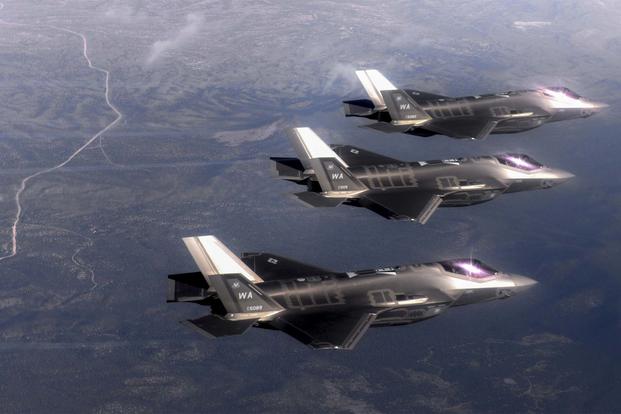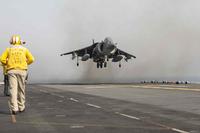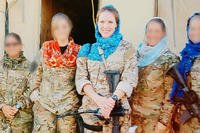The U.S. Air Force's years-long pipe dream of outsourcing a significant amount of its "red air," or adversary air, training for its combat forces may soon become reality as defense companies are lining up to offer up their pilots and newly-modified aircraft.
The idea is simple: Get contracted pilots, many of whom are U.S. military retirees, to fill the red air gap, allowing more active-duty pilots to attain air-to-air training on the friendly, or "blue air" side.
Officials say contracting out the aggressor air may be the only card the service has to play amid an increasing pilot shortage that doesn't seem to be slowing down.
"In a perfect world, we'd have the resources to maintain the aggressor squadrons that we used to have and kind of do it in house with modernized threats," Gen. Mike "Mobile" Holmes, head of Air Combat Command, told reporters during the Air Force Association's Air, Space and Cyber Conference last week in National Harbor, Md. "In the world we're living in now, we're limited in personnel and end strength."
Related content:
- 2017 AFA'S Air, Space & Cyber Conference
- How Many Fighter Jets Does the Air Force Need?
- Air Force Boosts Pay Incentives, Targets Retirees Amid Pilot Shortage
"I'd have to trade an operational fighter squadron for an aggressor squadron if I was going to do it in house right now because of limits ... from the budget, because of limits on the people I have in the Air Force and limits in time," said Holmes, an F-15 Eagle pilot who assumed the position in March.
He added, "If we can bring on some contract red air, then not only do we get some dedicated people to train against, we also reduce the amount of time that our crews are spending at a zero-sum budget for flight hours pretending to be somebody else instead of training for their primary skills."
'$400 million per year'
In a follow-up interview with Military.com, Holmes estimated a contract to outsource the mission would cost roughly $400 million per year, but added it would still be cheaper than depleting the Air Force's budget for training and flight hours to act as the enemy.
Holmes said it's the sorties and flight time that need to be increased.
"The requirement is the sorties, not a set number of aircraft/aircrew associated with that," ACC spokesman Col. Tadd Sholtis told Military.com in an email. "It's roughly $400 million per year for the sorties needed for adversary air at Nellis, our ACC fighter training units, and F-22/F-35 combat wings."
The Air Force estimates roughly 37,000 to 40,000 hours of flight time is needed to support aggressor air at a dozen bases across the U.S. In the meantime, defense companies are saying that that amounts to at least 150 aircraft in order to sustain those kinds of flights.
The move would mean time better spent for airmen who need more practice to beat the adversary, especially going forward in a high-end fight, Holmes said.
"I need more of them training as blue," he said.
Holmes added the Air Force plans to define its requirement for red-air outsourcing this fall.
'A Crisis in 2 Years'
Some hope the Air Force comes to a decision on red air soon as a change like this could redefine the mission, a fighter pilot told Military.com.
"This will be a crisis in about two years," said the pilot, who asked not to be identified.
In some cases, pilots tasked with red-air missions are just going through the motions instead of getting critical skills they need while airborne, he said, adding, "there's just not enough people to do that."
The pilot argued that a contract with an outside company "makes sense" because it can send pilots with a variety of skills all over the country, including the Weapons School at Nellis Air Force Base, Nevada -- or the Air Force's version of 'Top Gun' -- to train on the latest and greatest techniques.
Additionally, it won't require active-duty pilots to take a temporary duty assignment to fly "all over the place just to be target practice," he said.
The Fifth-gen Challenge
The training comes down to an air-to-air battle of simulated attacks for the purpose of enhancing tactics and techniques should pilots find themselves in an aerial dogfight, or having to stave off the enemy.
These days, aggressor pilots take to the skies where fighter jets like the F-22 Raptor and F-35 Joint Strike Fighter await the stand-off to practice. And they lose, big time.
To be clear, that is what the Air Force wants: for its "blue air" guys to get those kills.
But it's quality training that the service is looking for, not quantity. And the "red air" pilots aren't getting the same experience if they just become easy targets.
In short, fighter pilots want a bigger beast.
"The F-22 guys are hungry to get at a fifth-gen adversary like a [Chinese] J-20," the fighter pilot said. "The problem is, no squadron can replicate it unless you have dedicated fighter [squadrons of aircraft like the F-35 or F-22] acting as adversary air ... and that'll never happen," he said.
But some companies are going to try.
Who's Got the Goods?
Aerospace defense companies such as Textron Airborne Solutions have been working for the last two years to acquire aircraft and give them the state-of-the-art avionics that could come close to what U.S. pilots could observe in a high-stakes environment.
Textron purchased Airborne Tactical Advantage Company, or ATAC, in 2016 to get serious about its effort. Military.com met with officials from Textron and ATAC to get their perspective.
"We've been around in this industry for 20 years," said Jeffrey 'JD' Parker, CEO of ATAC.
ATAC flies about 5,000 hours a year for the U.S. Navy's opposing force flight training, operating about 25 jets for the effort, Parker said during an interview.
The Air Force is learning from the service that beat them to the punch on aggressor air.
"We are taking advantage of the work the Navy has done," Holmes said, "and a lot of people who will bid on our contract have experience and time working with the Navy and they bring capabilities they've developed with the Navy, [so] they'll bring them to us."
Textron-ATAC recently purchased 63 F-1 Dassault Mirage aircraft -- of which 45 will be pitched for Air Force aggressor flight, Parker said. It's part of the company's three-pronged approach to give the service a variety: the French Mirages, plus a "couple other packages of aircraft that supply high-end requirements, and a couple of fourth-gen-like capabilities."
The company's plan goes hand-in-hand with the Air Force's draft request for proposal: subsonic aircraft with basic radars; supersonic-capable aircraft with more enhanced radars; and finally, a high-performance, highly-end radar aircraft such as an F-16 Fighting Falcon adorned with active electronically scanned array (AESA) radars, which could include some other desired technologies like electronic attack.
"Bottom line is, that's what it's going to take just to begin to satisfy, scratch that itch, for the Air Force," Parker said
Parker reiterated that 150 aircraft would be a good start to fulfill the service's needs. "That's still far more than what industry has collectively," he said.
Draken International, Discovery Air Defence Services-Top Aces Inc., and TAC Air, are other companies who are "becoming serious" about the latest pitch, industry officials have said.
"We are definitely the oldest, I believe we're the largest on a tactical scale, only ones operating supersonic jets already," Parker said.
But that's not to say Textron-ATAC is coming out on top should a deal be made. Both Parker and Russ Bartlett, president and CEO of Textron, said that because of the Air Force's exponential hours requirement, it's likely -- no matter if one, two or four companies receive a contract -- there will be an aircraft capability gap for the first few years in the program.
"You look around the world, and there's only so many aircraft that meet that capability or can be upgraded ... and that are available, that are supportable," Parker said.
Textron-ATAC for now will move, refurbish and buy what it needs to get ready "for when the Air Force does decide what they want exactly," Parker said.
"You've got to lean forward in advance or you get left in the dust," Parker said.
A Temporary Solution
The Air Force is sticking to its mantra that the program is meant to be a temporary solution for aggressor training. Yet officials at Air Education and Training Command -- which oversees preliminary training for the youngest recruits coming into the Air Force -- say they too want to buy into the program.
"ACC needs it for their continuing training, and we need it for initial training," said Lt. Gen Darryl Roberson, commander of AETC.
Roberson said that AETC is working with Holmes and leaders from ACC to get a better sense of how each command can benefit.
"We can't afford to have two F-35s fighting against two F-35s when the cost per flying hour is so expensive. And it's not optimizing what the airplanes are really built for," Roberson said.
The cost to fly an F-35A per hour is $42,606, while an F-22 is $64,287, according to the Air Force's 2016 operational cost for Air Force aircraft data sheet.
Roberson clarified, "We're only in the training business. I'm not in the adversary threat world. However, we need adversary air for training, [too]."
Roberson added that companies who are planning to bid know what they're getting into. The general, echoing Holmes, said, "We do believe it's going to be temporary."
So why should companies buy into it?
"There is a demand signal that is high, and there's going to be profit margin for companies in the meantime. So they're going to probably meet whatever air requirements are out there, knowing in the long term they're going to have to adapt if they want to continue to provide services for us.
"I can't answer why a company would take this on as a business strategy or not," Roberson said. "All I can say is there's a requirement, and that some of these companies see a profit that can be made."
-- Oriana Pawlyk can be reached at oriana.pawlyk@military.com. Follow her on Twitter at @Oriana0214.




























